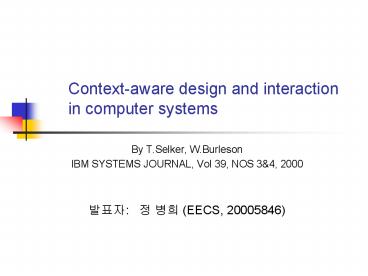Contextaware design and interaction in computer systems - PowerPoint PPT Presentation
1 / 12
Title:
Contextaware design and interaction in computer systems
Description:
Aesthetics, ergonomics and cognitive science are important factor in user interface design ... Promote aesthetics, ergonomics, and their relationships to ... – PowerPoint PPT presentation
Number of Views:46
Avg rating:3.0/5.0
Title: Contextaware design and interaction in computer systems
1
Context-aware design and interaction in computer
systems
- By T.Selker, W.Burleson
- IBM SYSTEMS JOURNAL, Vol 39, NOS 34, 2000
- ??? ? ?? (EECS, 20005846)
2
Contents
- Introduction
- Framework
- Task model
- User model
- System model
- Design prototypes of context-aware systems
- Noncomputational models
- Context-aware computer systems
- Sensor-based systems
- Multifunction systems
- Proactive model-based systems
- Conclusion
3
Introduction (1/2)
- The fields of design and computer science are
beginning to merge - Macintosh vs. iMac
- Aesthetics, ergonomics and cognitive science are
important factor in user interface design - Traditional design paradigm is broadening the
structured design process for human computer
interfaces - Engineering design paradigm
- Break the problems down into parts and apply the
standard solutions - Traditional design paradigm
- Promote aesthetics, ergonomics, and their
relationships to functions
4
Introduction (2/2)
- Issues of contextual interaction and knowledge
about peoples desired activities and actions
affect the design process - Contextual information can be used to reduce the
amount of explicit input a person is required to
give a computer - What and where the user task is
- What the user knows
- What the system capabilities are
- New technologies open possibilities for
context-aware systems - Development of new and sophisticated sensors
- Recognition technology
5
Framework
- Task model
- The acts that a person performs to accomplish a
task with a system - Ex) task at the threshold open a door, See if
someone is inside - User model
- Task-relevant background information about the
user - User comfort and user congruency depends on his
habit, self-image, and even issues of motivation - System model
- Refer to the capabilities of the computer system
its structure and ability to accomplish an
existing task
6
Design prototypes of context-aware systems (1/6)
- Noncomputational models
- Out-Of-Box Experience
- Task model
- - The person is setting up a notebook computer
- User model
- - A novice opening a computer for the first time
- System model
- - The paper instructions are near the components
they describe and are revealed as the person
opens the computer
7
Design prototypes of context-aware systems (2/6)
- Sensor-based systems (1)
- Flexor
- Task model
- - Recognized contextual communication through
arm motion - User model
- - Arm movement
- System model
- - Arm-bending sensor to evaluate motions made by
arm - 1) dancing flashes a varying sequence of
lights sounds - 2) exercising counts how many
repetitions have been completed
8
Design prototypes of context-aware systems (3/6)
- Sensor-based systems (2)
- Task model
- - Two-way interaction with the office task model
and office occupant model - 1) bringing someone in
- 2) rescheduling a meeting
- 3) leaving a message
- User model
- - Walks by in order to find out if a colleague
is in his office - System model
- - Relies on two switches(inside outside)
- - Coupling to voice recognition Microsoft
Office
- Digital Threshold
9
Design prototypes of context-aware systems (4/6)
- Multifunction systems (1)
- Task model
- - Work differently for two diverse situations
- 1) for a standard notebook computer
- 2) used as a LCD panel for an overhead
projector - System model
- - A person could remove the plastic back cover
from the LCD panel - - Place the laptop computer screen on an
overhead projector - - The user could place a finger on the LCD panel
like a transparency
- IBM ThinkPad 755CV
10
Design prototypes of context-aware systems (5/6)
- Multifunction systems (2)
- Task model
- - Reduces the physical materials in a persons
pocket (paper, money, credit card, etc) - - Improve the ability to identify carrier,
record the financial transactions, etc - System model
- - Deliver and record important documents
- - Communicate wirelessly
- - Display information
- - Leather wallet design
- Electronic Wallet
11
Design prototypes of context-aware systems (6/6)
- Proactive model-based systems
- The system drives or trades off control with the
user
- COACH
- Task model
- - A software agent that creates a dynamic user
model by observing user interactions with respect
to frequency, duration, and efficiency of use - Separates the task, user, system model for
learnable things - - Novice, intermediate, professional and expert
- Music Ball
- Task model
- - The ball-user collaboration creates a language
of sounds and associated motions - System model
- - Uses AI strategies for music teaching
structure - - Communicates with an enunciator and a motion
sensor
12
Conclusion
- The context-aware design framework focuses on
design that accounts for contextual information
or settings - Why ) Reduces communication barriers by analyzing
- What can be known about a user
- How to support that information with task, use
and system models - This paper has shown how context can be embodied
in the form and material of design, in the
internal models and in computer reactions - For diverse contexts
- At different levels of complexity































